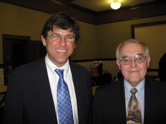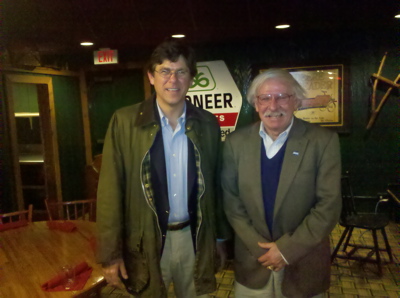Last night I had the great pleasure to be with the Great Plains Chapter of the National Railway Historical Society. We were in Grand Island, NE, in the historic Burlington depot at 603 Plum St. Over forty railroad enthusiasts and historians showed up on a snowy Saturday evening for the banquet. Of course, the depot is no longer in service but it still sits right next to the Burlington tracks, which have been elevated, and the coal trains came by regularly throughout the proceedings, rumbling south toward Lincoln and then on to Kansas. The local railroad modeling club has turned the old baggage room in the depot into a fantastic railroad model of both the Burlington local scene and the Union Pacific, complete with reconstructions of historic buildings, 50s cars, and landscape backgrounds. These rail lines intersected and crossed in Grand Island, making one of the most colossally congested intersections in American railroading.

With James L. Hanna, the president of the local chapter, February 26, 2011.
Not surprisingly, the participants in this society know a great deal about railroads, historic structures, and history, especially about the local railroads and old depots. Jim Reisdorf has published numerous books of history and photographs and old postcards of the local depots. Other experts were on hand as well. The Society is full of railroad history specialists who are concerned with historic preservation and sharing history with the public. I was pleased to be invited to talk with this group and to be part of the banquet. Everyone was generous and we had some great questions on how railroads shaped modern America.

In the old Burlington depot, 603 Plum St., Grand Island, NE, February 26, 2011.
No trip to Grand Island at this time of year is complete without stopping to see the migration of snow geese, Canadian geese, and the spectacular sand hill and whooping cranes. The cranes were farther west, but I managed to watch tens of thousands of snows and Canadians landing in a nearby field. An amazing sight and sound of the Great Plains.

Thousands on thousands of geese and cranes in migration, February 26, 2011, Grand Island, NE.
